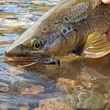We’ve often recommended streamer tactics that break the conventional long-distance mold. That is, presentations that eschew long casts and long swings or retrieves in favor of working up close and personal. It’s easy to recommend this approach with confidence, as these short-distance tactics work and work well on rivers, streams, and creeks all over the world. There are a variety of reasons why these tactics work so well and so consistently, some of which we’ve explained in other articles, like this one. And, every now and then, the river offers reminders.
Slovenia’s Unica River is known primarily as a stronghold of European grayling, including a handful of specimens that push past the twenty-inch mark. Absolutely bursting with bug life, the Unica is also an excellent and dependable dry fly fishery, with days when the fish aren’t rising far less common than those when they are.
The placid pace of the river, which is actually a spring creek, means anglers plying the Unica’s waters for grayling and trout are commonly toting along 3 and 4 weight rods or even more lightweight models. And we were as well, one day this past May, happily casting high-floating dries to eager grayling, the European variety of which is a tad trickier to hook due to having smaller mouths than their Arctic and Mongolian counterparts. The grayling’s frequent failure to imbibe flies they intended to take produced no shortage of cheerily delivered expletives, groans, and laughs as confident eats were often followed by missed hooksets. It was one of those days of good catching, where everything relaxes, morale soars, and every facet of the process of fly fishing plays out blithe and carefree.
We’d been watching a plump grayling happily rising on the edge of a weed bed, one of the largest we’d seen that day. A well-delivered cast landed a fly a few feet upstream of the grayling, sure to be carried by the Unica’s current straight to our intended target. Before the grayling even had a chance to inspect the fly, a precious brown trout, no more than 6 or 7 inches long, emerged from beneath the weed bed and snatched it up. Given the tenor of the day, this too elicited laughter and jeers, while the diminutive brown trout took off for the shelter of a nearby, heavily shaded undercut bank. As the tension of the line pulled back against the fleeing fish, it repeatedly erupted from and crashed back down to the water’s surface, causing a great deal more commotion than anyone might have expected a half-footlong trout could be capable of.
I paid little mind to the trout’s leaping acrobatics, knowing the nearby grayling wouldn’t care and waded out towards the weedbed to retrieve it while fending off some well-intentioned shit-talk from my companions. I dragged the spastic fish near, half in the water and half out, with the supple 4-weight I’d been casting when, as I was reaching down to palm the little trout, a comparatively massive shape shot out from the shadowed bank and snatched it away, darting below the weedbed with its prey.
“Huchen!,” I shouted, speaking before I could think. Knowing huchen, otherwise known as Danube taimen among other names, swam in Slovenian waters, my brain reflexively deduced this to be the most likely explanation for what I’d just witnessed. Certainly, this deduction was fueled by the fact that I’d have been elated to have an accidental encounter with a hucho hucho, a fish of 1,000 casts who many anglers spend entire seasons trying to catch, and whose season doesn’t begin until the autumn months.
This, too, produced a bit of gut busting. “There are no huchen in the Unica,” Nina, our guide, teased as if I was supposed to know this. “Must be a brown trout."
As the only one that had gotten a good look at what had transpired, I confidently protested, assuring the two onlookers that what had snatched up the little fish was most certainly not a brown trout. If it was, I disclaimed, it was the biggest brown trout I’d ever seen in a river of this size anywhere on the planet. Just then, the fish showed itself, its telltale pattern revealing it to be a pike. Pike are known inhabitants of the Unica. But while widespread in the river’s lower reaches, they’re rarely seen on the upper river where we were.

No sooner than we got a good look at the fish, it spit out the now considerably injured brown trout, most likely because it also got a good look at us. The brown limped its way to the surface, swimming irregularly, and we assumed the bewildering ordeal to have come to an abrupt end. As Nina walked out to net the trout, again the pike emerged, this time from the weedbed, reclaiming its prize.
The fish seemed aware of us and determined to win its meal. And we figured it would. Easily. After all, this time the pike had the brown trout halfway down its throat rather than clenched in its teeth as before, leaving us fighting a reasonably sized pike on a 4-weight and a piece of 5x tippet. Surely, it would only be seconds, if even multiple, before one of the pike’s hundreds of backwards-slanting teeth sliced the supple tippet and the line went limp.
I’ll tell you what happened next, but you probably won’t believe it. After a bit of bulldogging, the pike again spit the trout out, chased it down for a third time, this time swallowing it fully. In the process, the fly was somehow freed from the trout and as the line was retrieved, instead of the tippet quickly slicing, the small dry fly — a size 18 if memory serves — somehow slipped through the pike’s gauntlet of teeth and wedged itself in the corner of its mouth. After a few more minutes of pushing and pulling, the tiny dry fly somehow remaining lodged in the pike, Nina net the fish. For the first time in hours, all three of us were silent. What was there to say?

So what does any of this have to do with short-range streamer fishing? Plenty. Consider an excerpt from the aforementioned article.
Casts are typically quartered upstream into fast water seams, tight to the trees or banks or other cover and are followed by brief swings—sometimes as little as a second or two—which are punctuated by short, relatively sharp jerks on the line or where the fly is drawn broadside through the target water. And then the whole thing is set in motion again and again, as Madero moves quickly through a run.
Seeing it for the first time, you might be prone, like me, to give a bit of a chuckle. Or glance at your buddy beside you with a bewildered look, wondering who could possibly expect such a fevered, almost violent style of fishing to yield any results.
As trout anglers, we’re taught to tread lightly. Walk slowly. Don’t create even a subtle wake in the water. Wear drab, camouflage clothing. If possible, be silent. And invisible. Deliver a fly that lands softly and gracefully. Avoid slapping your line or fly down harshly. Do any less, and you’ll send fish fleeing. Most certainly, don't create a blur of busting and crashing water or every fish within 100 yards will have headed for the proverbial hills. Or will they?
Stealth as an angler is invaluable and should be practiced with dedication and care—when it aligns with your approach. When casting dry flies to sipping trout on a placid creek you should indeed endeavor to be as silent and unseen as possible.
But short range streamer fishing is an entirely different ball game. A stealthy presentation isn’t required, because the response you’re trying to elicit from the fish isn’t one predicated on an environment of regularity. It’s one driven by chaos. In the anecdote related here, that chaos was created by a small, struggling, hapless brown trout. The turmoil created by the hooked little trout triggered the ambush predator lurking along the banks to emerge from its lie and strike.
It’s that same chaos that you as an angler can seek to produce when fishing streamers up close and personal. Short lines, short deliveries, heavy flies on weighted tips, crashing and busting through tree branches and other overhanging vegetation, smashing through the water’s surface like a dropped cannonball — this is often the world of short-range streamer fishing.
Employing it for the first time, it’s an approach your instincts will tell you can’t possibly produce anything but failure. Don’t listen.































Comments
Vance Regan replied on Permalink
This sounds like what I've learned watching videos and reading books by Kelly Galloup.
alex replied on Permalink
I often fish my local stream (really a large creek) in early spring when elevated and discoloured. I cast large black wooly buggers in short casts to all likely spots - up stream and across, rarely more than 20 feet. Takes are usually explosive and typically within a second of the fly touching the water. Best thing about this fishing - the big fish come often come out to play.
Pages